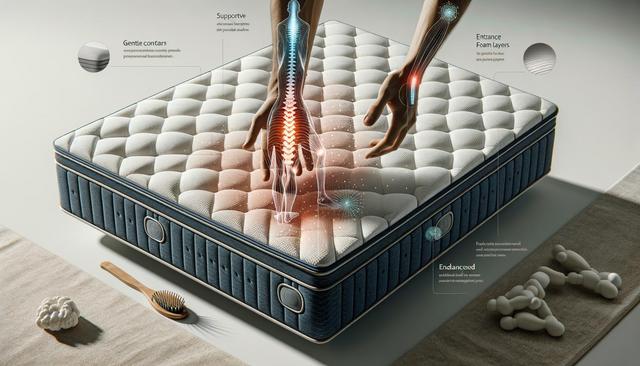
Choosing the Right Mattress for Sciatica Relief
Understanding Sciatica and Its Impact on Sleep
Sciatica is a condition where pain radiates along the sciatic nerve, which runs from the lower back through the hips and buttocks and down each leg. This discomfort can significantly interfere with sleep quality, making it difficult for individuals to find a comfortable sleeping position. When living with sciatica, choosing a suitable mattress becomes crucial. A mattress that offers balanced support and cushioning can help minimize nerve compression and reduce nighttime pain. By alleviating pressure points, the right mattress can contribute to improved spinal alignment and a more restful sleep experience.
Many people with sciatica experience worse symptoms at night, especially when lying on surfaces that are too firm or too soft. A mattress that is either extreme can disrupt spinal posture, increasing strain on the lower back. Therefore, understanding how different mattress types and materials interact with body weight and sleep style is key to managing sciatica pain effectively.
Key Features to Look for in a Mattress for Sciatica
When evaluating mattresses for sciatica support, several features stand out as particularly important. Each of these can play a role in reducing stress on the lumbar spine and promoting a more comfortable sleep posture. Here are some essential characteristics to consider:
- Firmness Level: Medium-firm mattresses often strike the best balance between support and comfort for those with sciatica.
- Pressure Relief: Look for mattresses that contour to the body, especially around the hips and shoulders, to reduce pressure on the sciatic nerve.
- Support Core: A sturdy base layer helps maintain spinal alignment throughout the night.
- Motion Isolation: Minimizing movement transfer can be especially helpful for light sleepers who experience pain-related awakenings.
Memory foam, latex, and hybrid models are commonly chosen for their ability to offer these benefits. Each material type has its unique advantages, so personal preference, body type, and sleep position should all be taken into account.
Mattress Types and Their Impact on Sciatica Pain
Different mattress constructions can have varied effects on sciatica symptoms. Understanding the pros and cons of each type helps narrow down your options. Here’s how common mattress types compare in supporting sciatica relief:
- Memory Foam: Known for contouring to the body, memory foam can relieve pressure points. However, some may find it retains too much heat.
- Latex: Latex mattresses offer a more responsive feel with solid support and natural cooling. They can be a good choice for those who prefer a firmer surface with pressure relief.
- Hybrid: Combining innerspring support with foam or latex comfort layers, hybrids provide a balanced option with enhanced airflow and good motion isolation.
- Innerspring: Traditional spring mattresses may lack the contouring needed for sciatica relief unless topped with a high-quality comfort layer.
Choosing a mattress that aligns well with your sleeping habits is essential. Side sleepers, for instance, may need more cushioning at the hips and shoulders, while back sleepers benefit from firmer support that maintains the natural curve of the spine.
Adjustable Bases and Sleep Accessories
While the mattress itself plays a central role in sciatica relief, complementary sleep accessories can further enhance comfort. Adjustable bed bases, for example, allow users to elevate their legs or upper body, which can ease nerve pressure in the lower back. Elevating the knees slightly can reduce strain on the lumbar spine and promote better circulation.
Other helpful accessories include:
- Pillows for Lumbar Support: Placing a small pillow under the knees (for back sleepers) or between the knees (for side sleepers) can maintain spinal alignment.
- Mattress Toppers: For those not ready to invest in a new mattress, a high-quality topper may add cushioning or adjust firmness levels to better support sciatica needs.
- Cooling Bedding: Since some materials retain heat, breathable sheets and pillows can improve sleep quality by regulating temperature.
These additions work best when used in conjunction with a supportive mattress. Together, they create a sleep environment that prioritizes spinal health and minimizes discomfort.
Making the Right Choice for Long-Term Relief
Choosing a mattress for sciatica pain is a highly personal decision that depends on individual symptoms, sleep preferences, and body types. However, the goal remains the same: to support proper spinal alignment and reduce pressure on the sciatic nerve. Taking the time to research and test out options is a valuable step toward improved comfort and long-term pain management.
When shopping, consider trial periods and warranties, as these offer peace of mind and flexibility. Many manufacturers now provide generous sleep trials, allowing users to evaluate the mattress in their own home. Additionally, customer reviews focused on pain relief and comfort can offer useful insights.
Ultimately, the right mattress can make a meaningful difference in managing sciatica pain and enhancing overall sleep quality. Whether you prefer the contouring nature of memory foam, the buoyancy of latex, or the balanced support of a hybrid, what matters most is finding a sleep surface that supports your body in a healthy, sustainable way.
Conclusion: Prioritizing Comfort and Support
For individuals dealing with sciatica, sleep can be a challenge—but the right mattress can offer significant relief. By focusing on features like pressure relief, spinal alignment, and supportive design, you can create a sleep environment that minimizes discomfort and promotes healing. Taking the time to explore your options and consider your personal needs will help you make an informed choice. With the right support system in place, restful nights and improved daily comfort are well within reach.


